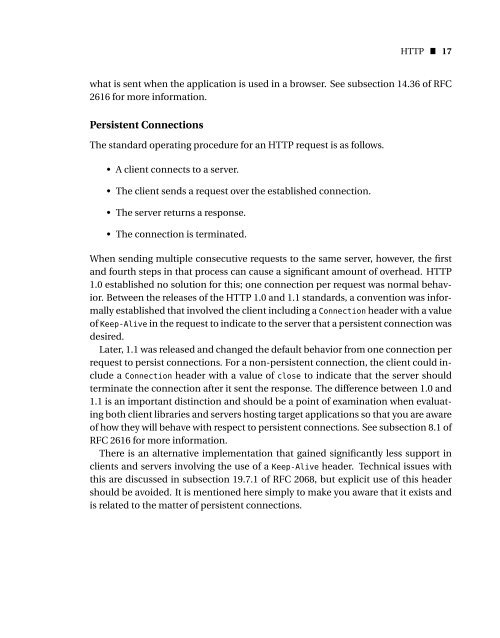php|architect's Guide to Web Scraping with PHP - Wind Business ...
php|architect's Guide to Web Scraping with PHP - Wind Business ...
php|architect's Guide to Web Scraping with PHP - Wind Business ...
Create successful ePaper yourself
Turn your PDF publications into a flip-book with our unique Google optimized e-Paper software.
HTTP ” 17<br />
what is sent when the application is used in a bro wser. See subsection 14.36 of RFC<br />
2616 for more information.<br />
P ersistent Connections<br />
The standard operating procedure for an HTTP request is as follo ws.<br />
• A client connects <strong>to</strong> a server.<br />
• The client sends a request o ver the established connection.<br />
• The server returns a response.<br />
• The connection is terminated.<br />
When sending multiple consecutive requests <strong>to</strong> the same server, ho wever, the first<br />
and fourth steps in that process can cause a significant amount of o verhead. HTTP<br />
1.0 established no solution for this; one connection per request was normal behavior.<br />
Between the releases of the HTTP 1.0 and 1.1 standards, a convention was informally<br />
established that involved the client including a Connection header <strong>with</strong> a value<br />
of Keep-Alive in the request <strong>to</strong> indicate <strong>to</strong> the server that a persistent connection was<br />
desired.<br />
Later, 1.1 was released and changed the default behavior from one connection per<br />
request <strong>to</strong> persist connections. F or a non-persistent connection, the client could include<br />
a Connection header <strong>with</strong> a value of close <strong>to</strong> indicate that the server should<br />
terminate the connection after it sent the response. The difference between 1.0 and<br />
1.1 is an important distinction and should be a point of examination when evaluating<br />
both client libraries and servers hosting target applications so that you are aware<br />
of ho w they will behave <strong>with</strong> respect <strong>to</strong> persistent connections. See subsection 8.1 of<br />
RFC 2616 for more information.<br />
There is an alternative implementation that gained significantly less support in<br />
clients and servers involving the use of a Keep-Alive header. Technical issues <strong>with</strong><br />
this are discussed in subsection 19.7.1 of RFC 2068, but explicit use of this header<br />
should be avoided. It is mentioned here simply <strong>to</strong> make you aware that it exists and<br />
is related <strong>to</strong> the matter of persistent connections.


